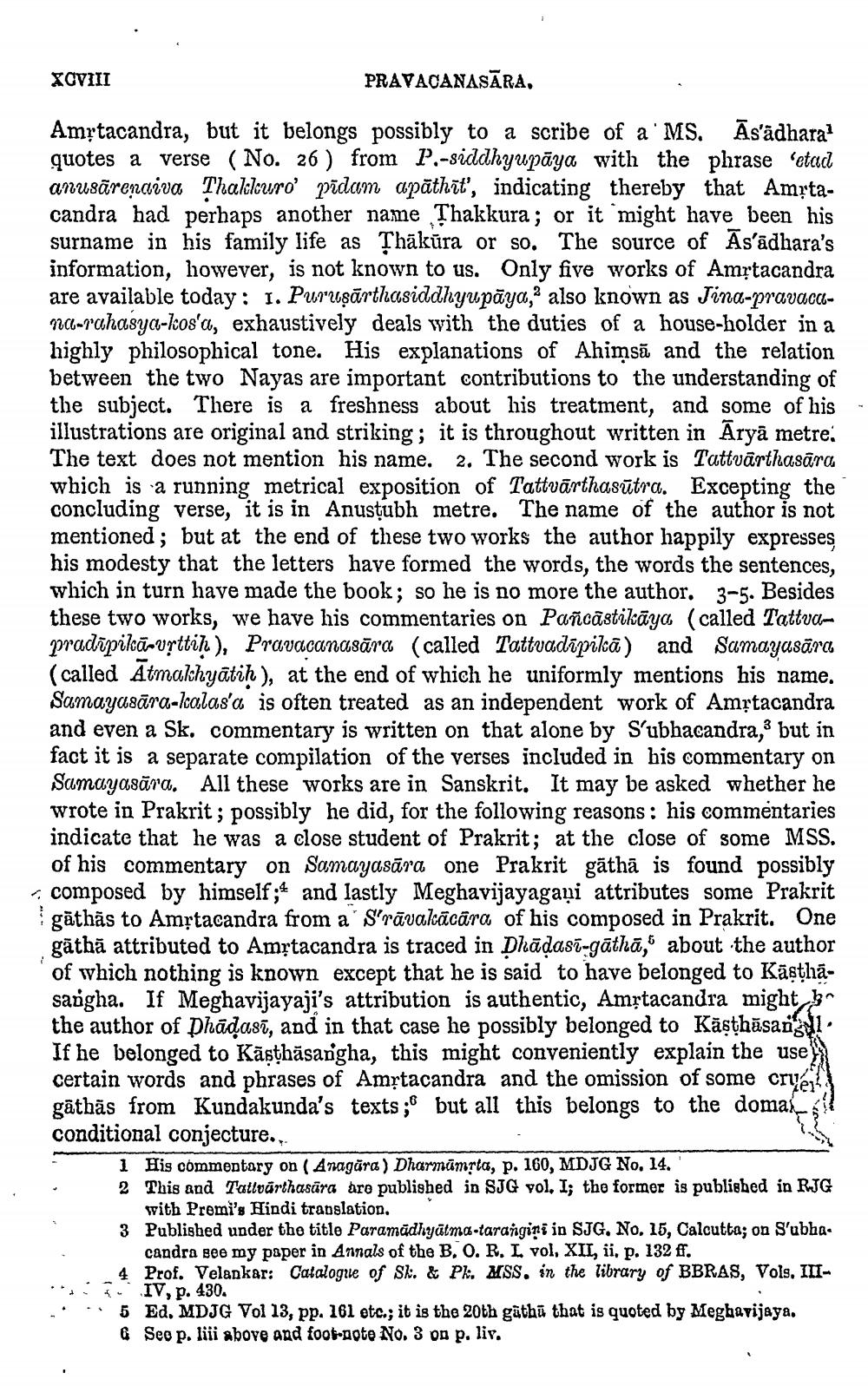________________
XCVIII
PRAVACANASĀRA,
Amrtacandra, but it belongs possibly to a scribe of a 'MS. Āsādhara? quotes a verse (No. 26 ) from P-siddhyupāya with the phrase "etach anusāreņaiva Thalclcuro' pīdam apāthīt", indicating thereby that Amrtacandra had perhaps another name Thakkura; or it might have been his surname in his family life as Thākūra or so. The source of As'adhara's information, however, is not known to us. Only five works of Amrtacandra are available today: I. Purzişārthasiddhyupāya, also known as Jina-pravacc920-rahasya-kosa, exhaustively deals with the duties of a house-holder in a highly philosophical tone. His explanations of Ahimsā and the relation between the two Nayas are important contributions to the understanding of the subject. There is a freshness about his treatment, and some of his illustrations are original and striking; it is throughout written in Āryā metre: The text does not mention his name. 2. The second work is Tattvārthasāra which is a running metrical exposition of Tattvārthasūtra. Excepting the concluding verse, it is in Anustubh metre. The name of the author is not mentioned; but at the end of these two works the author happily expresses his modesty that the letters have formed the words, the words the sentences, which in turn have made the book; so he is no more the author. 3-5. Besides
ese two works, we have his commentaries on Pañcâstikāya (called Tattua.pradūpikāovrttiņ), Pravacanasāra (called Tattvadīpikā) and Samayasāra (called Atmakhyātih), at the end of which he uniformly mentions his name. Samayasāra-Icalas'a is often treated as an independent work of Amộtacandra and even a Sk. commentary is written on that alone by Subhacandra, but in fact it is a separate compilation of the verses included in his commentary on Samayasāra. All these works are in Sanskrit. It may be asked whether he wrote in Prakrit; possibly he did, for the following reasons: his commentaries indicate that he was a close student of Prakrit; at the close of some MSS.
of his commentary on Samayasāra one Prakrit gāthā is found possibly . composed by himself;4 and lastly Meghavijayagaại attributes some Prakrit
gāthas to Amệtacandra from a Srāvalcācāra of his composed in Prakrit. One gāthā attributed to Amrtacandra is traced in Dhādasī-gāthā, about the author of which nothing is known except that he is said to have belonged to Kāşthāsargha. If Meghavijayaji's attribution is authentic, Amrtacandra might, the author of Phādasī, and in that case he possibly belonged to Kāşthāsana If he belonged to Kāşthāsargha, this might conveniently explain the use) certain words and phrases of Amrtacandra and the omission of some cruel gāthās from Kundakunda's texts ;but all this belongs to the domas ! conditional conjecture...
1 His commentary on ( Anagăra) Dharmāmsta, p. 160, MDJG No, 14. 2 This and Tattvārthasāra are published in SJG vol. I; the former is published in RJG
with Premi's Hindi translation, 3 Published under the title Paramādhyatma-tarangini in SJG, No. 15, Calcutta; on s'ubha
candra see my paper in Annals of the B. O. R. I vol, XII, ii, p. 132 ff.
4 Prof. Velankar: Catalogue of Sk. & PL. MSS. in the library of BBRAS, Vols. III**
IV, p. 430. 5 Ed. MDJG Vol 13, pp. 161 etc.; it is the 20th gathū that is quoted by Meghavijaya. G Seo p. liii above and footagte No. 3 on p. liv.




